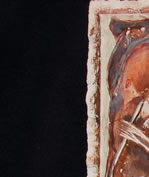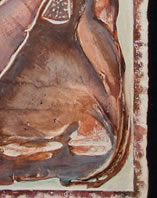 |
|
||||
| Previous | Gallery | Next |
 |
 |
 |
|||||
 |
 |
 |
 |
||||
WARRAMURRUNGGUNDJI COLORS used in this piece are a fusion of red oxide, raw umber, burnt umber, fresh blueberry wash, and moss translucent glaze.The two figures are accented with the translucent glaze giving a vaporous look to the piece. BACKGROUND is eggshell highlighted with moss translucent glaze. TEXTURING is accomplished with convex applications of gypsum lending to the three- dimensional effect of the artwork. Edges of prepared board have a rock-texture appearance highlighted by a raised, carved border. SIZE 12”H x 12”W CULTURAL INSPIRATION: Warramurrunggundji, believed to be the portly woman on the left and her leaner female companion both have dilly bags hanging down their backs. (Dilly bags also called “yakou”, “yibali” or “but but bags” are used to carry food and material possessions. They are made from different material including hand spun bush string, grasses, vines, pandanus fiber and animal sinew. ) The Aboriginal people believe that their land and everything living in it, including themselves were created by mythical figures. The ancestral past, often referred to as the “Dreaming” is a time of creation. It is the tangible evidence of their existence, carried out in rituals and ceremonies. Rock paintings are associated with the “Dreaming” evidence of where these creation heroes activities took place, sites that are marked by their journeys and the essence of themselves left on the walls of the shelters. Landscape can also mark their territory. A spring and a rocky outcrop are evidence of their presence to the Aboriginals. Spencer recorded in his travels that Imbromebera was responsible for many of the unusual present-day landscape that she populated with plants, vegetables and animals. The Aboriginals believe that everything has life, including the landscape and their ancestors who are so poignantly sung about in the “Dreaming” ceremonies gave this life to them. Warramurrunggundji, a female creator ancestor came from the Arafura Sea at Cobourg Peninsula and moved inland. In 1881 Paul Foelsche, inspector of police, first reported her to Europeans. In 1912 Baldwin Spencer gave an explicit version of the Warramurrunggundji myth during his visit to Oenpelli. She has been associated with the planting of vegetable food, leaving the first group of humans with their language and name and at Oenpelli leaving spirit children. To the Gagudju she was known as Imbromebera and her spouse was Wuraka. The spirit couple purportedly continued their journey until the man Wuraka “sat down”, and was too tired to carry his heavy penis. He is known to the local populace in a prominent landmark called Wurragag and referred to in English as Tor Rock. |